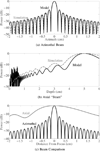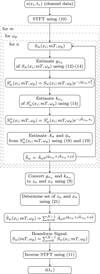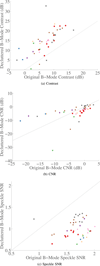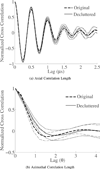Ultrasonic multipath and beamforming clutter reduction: a chirp model approach
- PMID: 24569248
- PMCID: PMC4090329
- DOI: 10.1109/TUFFC.2014.2928
Ultrasonic multipath and beamforming clutter reduction: a chirp model approach
Abstract
In vivo ultrasonic imaging with transducer arrays suffers from image degradation resulting from beamforming limitations, including diffraction-limited beamforming and beamforming degradation caused by tissue inhomogeneity. Additionally, based on recent studies, multipath scattering also causes significant image degradation. To reduce degradation from both sources, we propose a model-based signal decomposition scheme. The proposed algorithm identifies spatial frequency signatures to decompose received wavefronts into their most significant scattering sources. Scattering sources originating from a region of interest are used to reconstruct decluttered wavefronts, which are beamformed into decluttered RF scan lines or A-lines. To test the algorithm, ultrasound system channel data were acquired during liver scans from 8 patients. Multiple data sets were acquired from each patient, with 55 total data sets, 43 of which had identifiable hypoechoic regions on normal B-mode images. The data sets with identifiable hypoechoic regions were analyzed. The results show the decluttered B-mode images have an average improvement in contrast over normal images of 7.3 ± 4.6 dB. The contrast-to-noise ratio (CNR) changed little on average between normal and decluttered Bmode, -0.4 ± 5.9 dB. The in vivo speckle SNR decreased; the change was -0.65 ± 0.28. Phantom speckle SNR also decreased, but only by -0.40 ± 0.03.
Figures









References
-
- Carson PL, Oughton TV. A modeled study for diagnosis of small anechoic masses with ultrasound. Radiology. 1977 Mar.122(no. 3):765–771. - PubMed
-
- Bly SHP, Foster FS, Patterson MS, Foster DR, Hunt JW. Artifactual Echoes in B-Mode Images due to Multiple Scattering. Ultrasound in Med. & Biol. 1985;11(no. 1):99–111. - PubMed
-
- Smith S, Trahey G, von Ramm O. Phased array ultrasound imaging through planar tissue layers. Ultrasound in Medicine & Biology. 1986;12(no. 3):229–243. - PubMed
-
- Mann JA, Walker W. A constrained adaptive beamformer for medical ultrasound: initial results. Ultrasonics Symposium: 2002. Proceedings 2002 IEEE. 2002;2:1807–1810. vol. 2.
-
- Tabei M, Mast TD, Waag RC. Simulation of ultrasonic focus aberration and correction through human tissue. J Acoust Soc Am. 2003;113(no. 2):1166–1176. - PubMed
Publication types
MeSH terms
Grants and funding
LinkOut - more resources
Full Text Sources
Other Literature Sources
Miscellaneous

